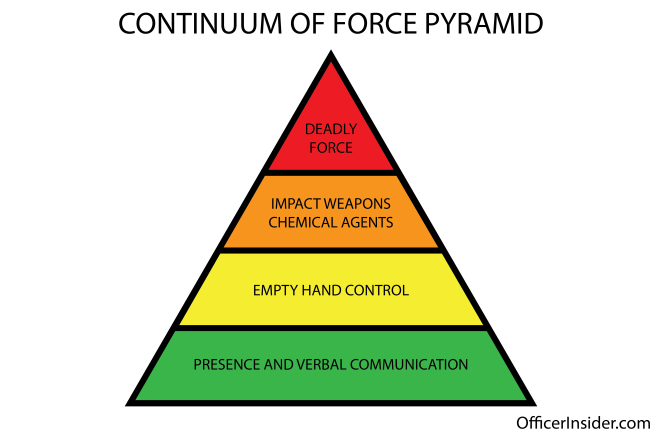“Must have excellent communication skills.”
No matter what part of the country you’re in, if you’ve ever applied for any sort of job, you’ve seen some variation of this line.
The security fields are no exception, where communication is crucial in a work environment filled with constant contact with people, some of whom may be extremely dangerous.
The Continuum of Force Pyramid
If you’ve been in the security industry for any amount of time, hopefully you are familiar with the use of force continuum, which is universally used to determine what types of force are appropriate at what times.
It takes many forms (here’s the text version for law enforcement presented by the National Institute of Justice), but it’s usually some sort of pyramid that looks something like this:

The Continuum of Force Pyramid applies to security personnel primarily in regards to the protection of life, not property. As I have stated in previous articles, property and funds can be replaced easily. Life and people cannot. To avoid incurring liability for yourself or your agency, I always highly recommend disengaging from a volatile situation that does not threaten the safety of other persons and contacting the police for assistance (after all, that’s what they’re there for).
The typical pyramid, starting from the bottom…
- Presence/Verbal Communication:
- By being present, the Officer acts as a deterrent against potential crimes. When signs that an incident may be imminent are apparent, the Officer uses verbal tactics to de-escalate the situation and gain compliance. No physical force is involved.
- Empty Hand Control:
- Upon encountering non-lethal resistance, the Officer employs the sufficient amount of force to gain compliance against the subject(s). No weapons or tools are involved (although restraints may be necessary to retain compliance). Once in control, the Officer disengages and returns to the previous step.
- Impact Weapon or Chemical Agents:
- Upon encountering force that cannot be overcome with empty hand techniques, the Officer employs the use of a baton or similar instrument, or a chemical agent to gain the needed leverage to transition back to empty hand control as described above.
- Deadly Force:
- Upon encountering any type of resistance that may cause grievous bodily injury or death to their person or persons around them, the Officer may employ any force necessary, up to and including the killing of the resistant subject(s) to gain control.
How to Gain Compliance
It is generally accepted your role as a security officer is to effect compliance with no force, or the minimum amount of force needed to accomplish the task at hand. Obviously, compliant folks (i.e. the majority of people you will run into on a daily basis) are no issue.
The use-of-force pyramid was developed as a guideline on dealing with non-compliant subjects after verbal de-escalation fails. That’s all well and good, but how do you use your words properly to effect compliance in a non-compliant subject?
In the many years I’ve spent in the security industry, every agency, director, supervisor, captain, sergeant has said the same thing: USE YOUR WORDS. DE-ESCALATE.
The best way to stop non-compliance is to avoid it in the first place.
This will be the first of a few articles I have planned to help you with that. By no means am I an end-all expert on the subject of de-escalation, however I have had my fair share of incidents and I feel that any help I can offer my fellow brothers and sisters in this field will be worth the effort.
In a future article (currently in progress!), I will share several verbal de-escalation techniques that have been extremely effective for me. I hope you’ll find them useful.
Until then, stay safe, my friends.
